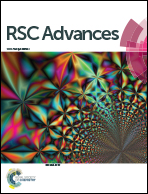Fabrication of α-Fe2O3–γ-Al2O3 core–shell nanofibers and their Cr(vi) adsorptive properties†
Abstract
α-Fe2O3–γ-Al2O3 core–shell nanofibers have been synthesized via an electrospinning process combined with vapor deposition and heat treatment techniques. The composite nanofibers exhibited ferromagnetic properties and Cr(VI) removal performance. The Freundlich adsorption isotherm was applied to describe the adsorption process. Kinetics of the Cr(VI) ion adsorption were found to follow a pseudo-second-order rate equation. The obtained α-Fe2O3–γ-Al2O3 core–shell nanofibers were carefully examined by scanning electron microscopy (SEM), transmission electron microscopy (TEM), X-ray diffraction (XRD), Fourier transform infrared spectroscopy (FT-IR) and vibrating sample magnetometry (VSM). The adsorption mechanism for Cr(VI) onto α-Fe2O3–γ-Al2O3 core–shell nanofibers was elucidated by X-ray photoelectron spectroscopy (XPS). The results suggested that the electrostatic adsorption between the positively charged surface of α-Fe2O3–γ-Al2O3 nanofibers and Cr(VI) species, and the electron–hole pair provided by Fe2O3 induced the Cr(VI) reduction to Cr(III). It is anticipated that the α-Fe2O3–γ-Al2O3 core–shell nanofibers are an attractive adsorbent for the removal of heavy metal ions from water.


 Please wait while we load your content...
Please wait while we load your content...